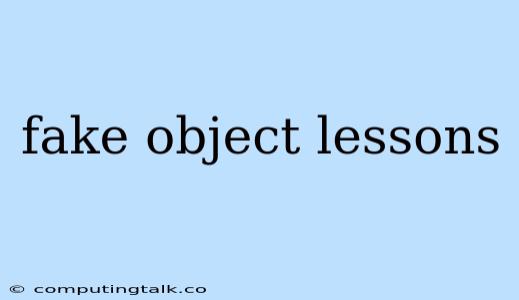Fake Object Lessons: A Powerful Tool for Teaching and Learning
The world of object-oriented programming (OOP) is built on the concept of objects. These objects encapsulate data and behavior, allowing developers to model real-world entities in their code. But what happens when we need to represent an entity that doesn't exist yet, or whose behavior is not fully defined? This is where fake objects come into play.
Fake objects, sometimes called mock objects, are a powerful tool for teaching and learning OOP concepts. They allow us to simulate the behavior of real objects without needing to implement them fully. This can be incredibly useful for a number of reasons.
Why Use Fake Objects?
- Simplify Learning: When learning OOP, it can be overwhelming to deal with complex dependencies and real-world objects. Fake objects provide a simplified environment, allowing students to focus on the core principles of object interaction without getting bogged down in implementation details.
- Isolate Logic: Fake objects help isolate and test specific pieces of code without relying on external dependencies. This is crucial for unit testing, allowing developers to ensure that their code functions correctly in isolation.
- Early Development: During the early stages of development, when features are not yet fully defined, fake objects allow us to write and test code against placeholder objects. This can help us identify potential issues and improve code quality early on.
Creating Fake Objects: A Simple Example
Let's imagine we are building a system that interacts with a remote database. We could create a fake object to represent this database:
class FakeDatabase {
constructor() {
this.data = {};
}
getData(key) {
return this.data[key];
}
setData(key, value) {
this.data[key] = value;
}
}
This fake object implements the essential methods needed for interaction with the database, but it doesn't actually connect to a real database. This allows us to write and test our code without relying on a real database connection, which can be time-consuming and prone to errors.
Using Fake Objects in Learning Scenarios
Fake objects can be effectively used in various learning scenarios:
- Coding Challenges: Create challenging scenarios for students, such as: "Implement a function that interacts with a fake bank account object, allowing users to deposit and withdraw funds."
- Workshops and Tutorials: Fake objects can provide a controlled environment for demonstrating OOP concepts in a step-by-step manner.
- Self-Paced Learning: Fake objects can help students practice implementing different object interactions without needing to set up complex real-world environments.
Key Considerations for Fake Objects
While fake objects are a valuable tool, it's important to consider these points:
- Clarity and Documentation: Ensure that the fake object's behavior is well-defined and documented, so that students understand its limitations and intended use.
- Realism and Simplicity: Strive to create fake objects that are realistic enough to represent real-world entities, but also simple enough to understand and use.
- Avoid Over-Simplification: While fake objects can simplify learning, it's important to avoid over-simplification, as this can lead to misunderstandings or incomplete knowledge.
Conclusion
Fake objects are a powerful learning tool in OOP, enabling students to grasp complex concepts in a simplified and controlled environment. They can be used to create engaging coding challenges, facilitate workshops and tutorials, and support self-paced learning. By carefully considering the design and use of fake objects, we can create effective learning experiences that foster deeper understanding of object-oriented programming.
